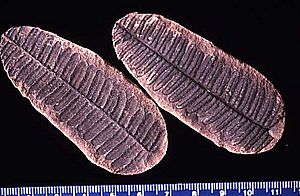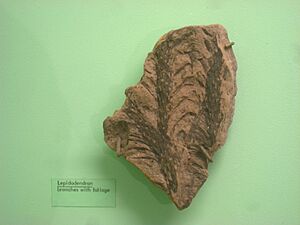Mazon Creek facts for kids
Mazon Creek is a very special place in northeast Illinois, USA. It's known as a lagerstätte, which means it's a site where fossils are incredibly well-preserved. These fossils are from a time called the Pennsylvanian sub-period of the Carboniferous period, about 309 million years ago.
In 1997, Mazon Creek was made a National Historic Landmark because of its importance. One of the most amazing discoveries found here is the oldest-known beetle fossil!
What Mazon Creek Looked Like Long Ago
Millions of years ago, the area where Mazon Creek is now was a huge tropical estuary. An estuary is where a river meets the sea, and it had many shifting channels, mud, and sand bars. A large, shallow sea sometimes covered this land, then pulled back.
This environment was perfect for forming coal. Imagine a low-lying tropical swamp or rain forest. When plants died, they fell into the water. Because there wasn't much oxygen in the water, the dead plants didn't rot away completely. Instead, they piled up, forming thick layers of peat.
From time to time, rivers would bring down lots of sediment (like mud and sand) from nearby mountains. This sediment would cover the swamp. Over millions of years, the layers of peat and sediment were buried deeper and deeper. The pressure and heat turned the peat into hard coal, and the sediment into hard rock. Later, these rocks were uncovered by erosion, allowing us to find the amazing fossils inside.
The huge amount of plants growing at this time created these coal measures. Many fossils were found in hard, round balls called concretions. These concretions formed because of a mineral called iron carbonate, which hardened the mud and plant material around the fossils.
Ancient Plants and Animals
Scientists have found an incredible variety of fossils at Mazon Creek. They belong to many different groups of plants and animals that lived there millions of years ago:
- Over 140 different kinds of insects and other arthropods (like spiders and centipedes).
- Animals that lived in fresh water, such as fish, amphibians, bivalves (like clams), crustacea (like crabs), and horseshoe crabs.
- Creatures from brackish water (a mix of fresh and salt water). These include tiny ostracodes, lungfish scales, ancient sharks called xenacanths, polychaetes (type of worm), more crustacea, cephalopods (like squids) with soft bodies, and even sea cucumbers.
- One very unique creature found here is the 'Tully Monster', Tullimonstrum gregarium. It's a soft-bodied marine animal that scientists still can't place into any known animal group! It's so special that it's the official state fossil of Illinois.
- About 400 different kinds of plants have been found. These include giant Lepidodendron trees, horsetails, many types of ferns, seed ferns, and early forms of conifers and ginkgoes.
Images for kids
-
Tullimonstrum gregarium fossil found in a concretion from Mazon Creek.
-
A fossil of Bandringa rayi, an ancient shark, from Mazon Creek. This is the first specimen of this species ever found. Its size shows it was a young shark.






